In early September, Teresa and I had definite plans to visit Italy while Amelia and Ryan were in Tuscany. We thought perhaps we would visit some other cities in Italy after Amelia & Ryan headed for Croatia, but travel planning is not our strong suit… The day before we left for Italy we started looking at maps and airfares and noticed $25 fares from Milan to Stockholm, and voila! that became the next city on our agenda.
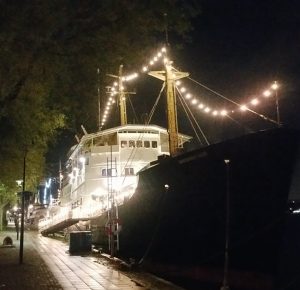
My family will tell you I’m a cheapskate when it comes to booking lodgings, but my brother Thure advised me, when in Stockholm, to spend more and stay near the old city center of Gamla Stan. Therefore I booked almost the cheapest place I could find near the city center and it turned out to be the Kronprinsessan Margaretha. We had booked lodging in an old (ca. 1927) passenger ferry, formerly shuttling passengers around the Baltic Sea. Turned out to be quite a nice place, and the most memorable of our lodgings in Scandinavia.
The history of this former passenger ferry was interesting, as was the history of the hotel. Apparently, the captain of the vessel saved some 500 shipwrecked Germans who had run aground sometime in the mid-1930s. Adolf Hitler was so grateful that he bestowed honors upon the captain. During the 1940s, the captain’s son was in a Norwegian resistance cell that was swept up by the Nazis. The captain, fearing for the life of his son, appealed for his life in a letter to Hitler, and the son was released. As for the hotel, at the time of the tech stock market crash of 2001, (before Google made it easy to look up hotels on-line) the owner somehow acquired exclusive rights to the word “hotel” for internet searches in Stockholm. For those knowledgeable enough to find hotels on-line, his hotel was the only one that showed up in Stockholm for several years, making a handy profit for him. At least, that’s what he told me…
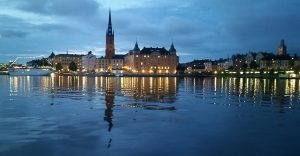
It was rainy while we were in Stockholm, but we managed to dodge the raindrops long enough to get a boat tour around the area. The island of Sodermalm is bordered by the waters of the Baltic Sea to the east, and Lake Malar (Malaren) on the west. It requires passing through a lock to get from one end of the island to another. According to a Vogue magazine article a few years ago, it is Europe’s hippest neighborhood now, but was once where the starving masses of Stockholm resided. During WWI, when starvation was staring many people in the face, the city government set aside some land on the south side for gardens to be allotted on a first-come first-serve basis – they are still doing it that way and are much in demand.
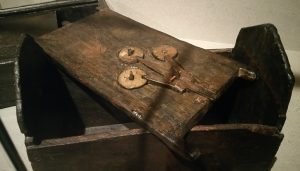
After our boat tour, we took a city ferry to the island of Djurgarden to visit the Vasa Museum. In 1628 the Swedish Navy launched a new warship, the Vasa – with a significant upgrade over all their previous naval vessels – 2 gun-decks, rather than just one. What they didn’t understand was the requirement for a broader beam and more ballast to support the additional load. The Vasa sank in Stockholm harbor 20 minutes after it was launched – just rolled right over and went down. It was recovered from the Baltic waters in the 1960’s, and is almost fully intact. The ship is adorned with hundreds of wooden sculptures and the paint job on it must have been quite a sight when it was launched. One of the more interesting museums I have visited, and apparently one of the most visited in Sweden.
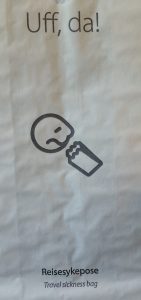
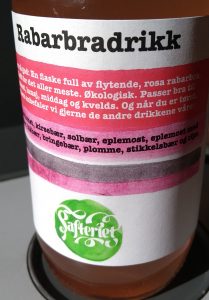
On Friday September 15, we took the bus west to Oslo. Not much to add about the bus ride, except an item of interest for our Rhubarb Aficionado friends in Minnesota. Apparently they make Rhubarb drinks in Norway as well as in “Little Norway”, ie southeastern Minnesota.
And of course, “Uff da!” is a thing in Norway, as well as in Minnesota!
On Saturday though, we decided on a train tour across the mid-section of Norway – from Oslo to Flåm – mainly to see the scenery en-route, but also to view the fjord if possible.
If you aim to sit and watch scenery all day, Norway is a pretty good place to go. Once we left Oslo, the scenery changed from quite pleasant to magnificent to stunning. There seemed to be quite a lot of folks out riding bikes – even way up above the treeline.
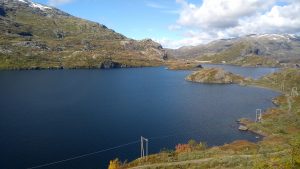
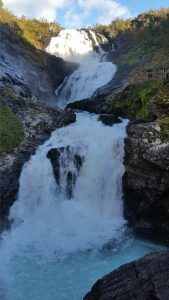
In this photo from above the treeline, you can see a long winding bike path alongside the lake.
When we got to the whistle-stop of Myrdal, we got off the mainline (which goes to Bergen on the North Sea coast) and took another line. This is where the scenery gets stunning! This short line runs north and terminates at Sognefjord. The railroad is a marvel, about 20km long, and includes an 18 degree grade as well as a tunnel with a 180 degree turn.
On Sunday the 17th, we boarded an overnight ferry for Copenhagen. We had time to kill before leaving, so we parked our luggage in the ferry luggage locker and strolled around Oslo for a while. Lots of green space and pedestrian paths along the waterfront in Oslo, as well as a magnificent Opera House to visit. From a distance, it looks like a ship rising out of the water.
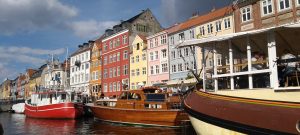
On Monday the 18th, we arrived in Copenhagen – of the three Scandinavian capitals we visited, probably my favorite. But I’m not sure why – perhaps the quirky character, or maybe just because the sun started to shine more. As we often do, we first oriented ourselves by taking a motor tour of the city – this one via canal boat. Back in the day, one of the Danish kings so admired the Amsterdam canals that he had some built in Copenhagen.
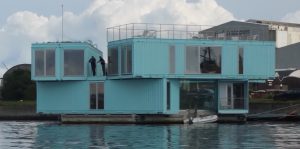
Often during our tour of Scandinavia I had noticed that shipping containers were often being used as construction trailers or housing units. I’ve seen them often enough in the US, but we saw a lot of them in Scandinavia, and for many other uses that I haven’t noticed in the US. During our canal tour, the shipping containers to the right were pointed out to us as a Student Housing Prototype. Then I noticed that, right across the canal from the prototype is the world headquarters of Maersk, the global logistics giant specializing in container shipping. So that’s what they do with all the excess containers! I was proud of myself for finally figuring it out 🙂
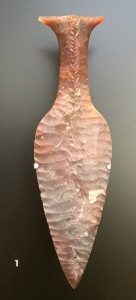
Tuesday was misty and murky, a great day for hanging out at the National Museum of Denmark. This was such a great museum that we spent almost 7 hours there – they kicked us out at closing time. It starts with Danish Prehistory, a story that is very long and well-preserved, due to all the bogs which tend to both hide and preserve all manner of things. There are also laws which require anyone finding antiquities to hand them over to the government — the finders are apparently compensated well enough that treasure hordes are repeatedly handed over without question or complaint.
Apparently, the Danes had a thriving trade in flint daggers back in the Stone Age, and the market seemed to keep going well into the Iron Age, but all good things must come to an end.
We had tickets for Wednesday to fly back to Barcelona, but not until late afternoon. The sun was still shining so we decided to go see the changing of the guards at the Royal Palace. When the queen is there, there is also a marching band followed by a short concert every day at Noon when the guard changes. Alas, she was out, but the guards do step smartly and they sure have nice big hats!
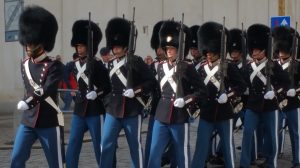
Fascinating stuff – thanks
Dave
WOW!!! I think that is enough said!!! You did a great recap. I LOVE the idea in use of containers. Tiny Homes has used them to create tiny homes here in the US.
Trish
Really enjoying your traveloge!
Thanks Elaine!